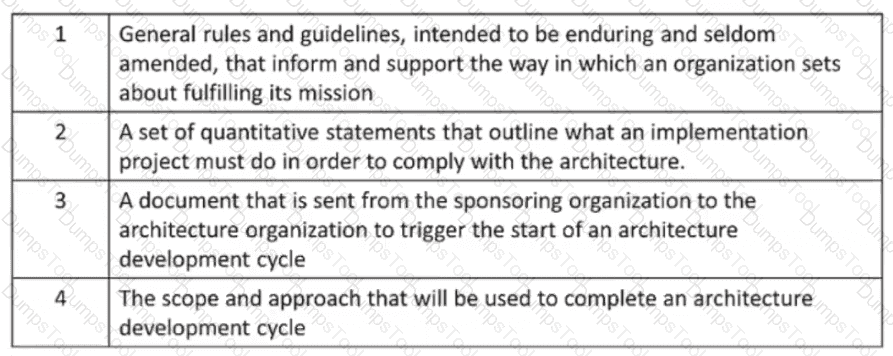Which of the following statements about architecture partitioning is correct?
Exhibit
Consider the illustration showing an architecture development cycle Which description matches the phase of the ADM labeled as item 2?
Consider the following statements.
1. All processes, decision-making, and mechanisms used will be established so as to minimize or avoid potential conflicts of interest.
2. More effective strategic decision-making will be made by C-Level executives and business leaders.
3. All actions implemented and their decision support will be available for inspection by authorized organization and provider parties.
4. Digital Transformation and operations will be more effective and efficient.
Which statements highlight the value and necessity for Architecture Governance to be adopted within organizations?
Complete the sentence. The purpose of the Gap Analysis technique is to _____.
Complete the sentence. The dimensions used to scope an architecture are time period, depth, and
Consider the following ADM phases objectives.
Which phase does each objective match?
Consider the following descriptions of deliverables consumed and produced across the TOGAF ADM cycle.

Which deliverables match these descriptions?
Complete the sentence The Architecture Landscape is divided into levels known as__________________________.
Which of the following statements about architecture partitioning are correct?
It is equivalent to architecture levels.
It enables different groups of architects to own and develop specific parts of an architecture.
It is implemented following a generally applicable partitioning model.
It is used to simplify the management of an Enterprise Architecture.
What can be introduced to formalize a joint agreement between development partners and sponsors on the deliverables, quality, and fitness-for-purpose of an architecture?
Complete the sentence. The four purposes that typically frame the planning horizon, depth and breadth of an Architecture Project, and the contents of the EA Repository are Strategy, Portfolio,
What structural framework does the TOGAF Standard define to support the management, leverage, and storage of architectural work products?
What is presented as ”striking a balance between positive and negative outcomes resulting from the realization of either opportunities or threats?
Consider the following ADM phases objectives.
Objective:
1.Develop the Target Data Architecture that enables the Business Architecture and the Architecture Vision
2.Develop the Target Business Architecture that describes how the enterprise needs to operate to achieve the business goals
3.Develop a high-level aspirational vision of the capabilities and business value to be delivered as a result of the proposed Enterprise Architecture
4.Identify candidate Architecture Roadmap components based upon gaps between the Baseline and Target Technology Architectures
Which phase does each objective match?
Complete the sentence. The purpose of the Preliminary Phase is to develop the:
Which section of the TOGAF template for Architecture Principles should describe the relationship to other principles?
Consider the following statements:
1. Each contracted party is required to act responsibly to the organization and its stakeholders.
2. All decisions taken, processes used, and their implementation will not be allowed to create unfair advantage to any one particular party.
3. Digital Transformation and operations will be more effective and efficient.
4. Strategic decision-making by C-Level executives and business leaders will be more effective.
Which statements highlight the value and necessity for Architecture Governance to be adopted within organizations?
What is used to structure architectural information in an orderly way so that it can be processed to meet stakeholder needs?
What is present in all phases within the ADM and should be identified, classified and mitigated before starting a transformation effort?
Complete the following sentence. In the ADM, documents which are under development and have not undergone any formal review and approval process are called______ Documents which have been reviewed and approved are called ______
In which section of the TOGAF template for Architecture Principles would a reader find the answer to the question of “How does this affect me?”
Consider the description.
The typical contents of the assessment include: an overview of project progress and status and project architecture/design.
Which form of assessment is described?
Consider the following statement.
Projects may cycle between ADM phases, in planned cycles covering multiple phases.
What does it illustrate?
According to the TOGAF standard, what term describes an individual with an interest in a system?
Consider the following statement:
According to the TOGAF Standard a governed approach of a particular deliverable will ensure a system of continuous monitoring to check integrity changes decision-making and audit of all architecture-related activities
Which deliverable is being referred to?
Complete the sentence. The architecture domains that are considered by the TOGAF standard as subsets of an overall enterprise architecture are Business, Technology,